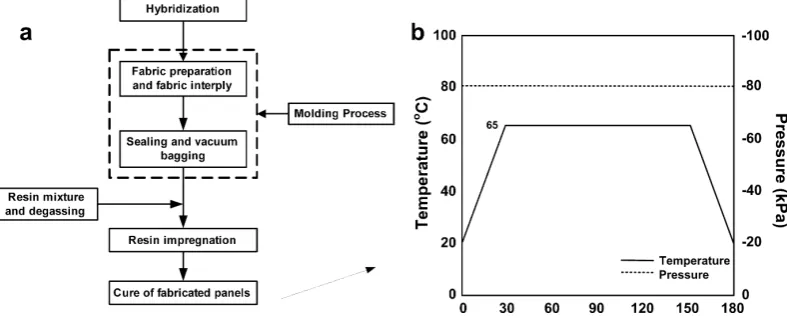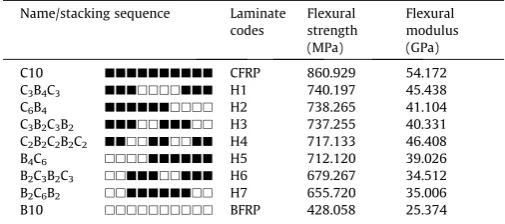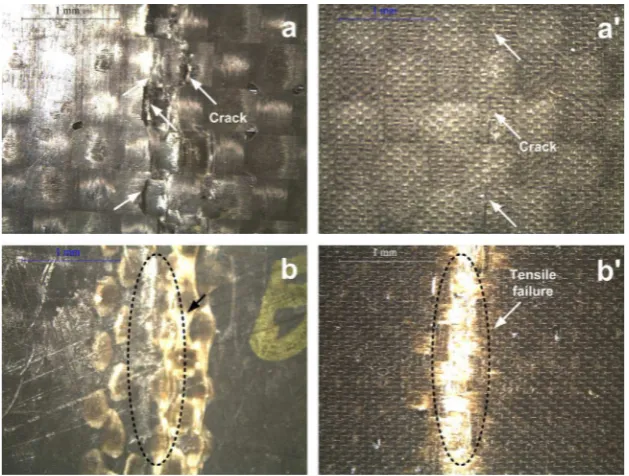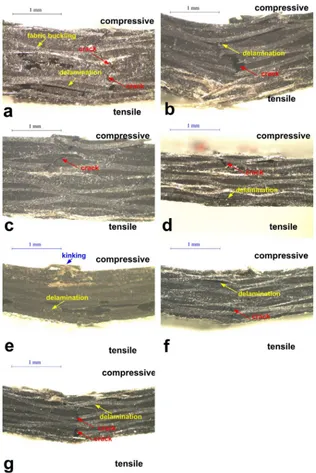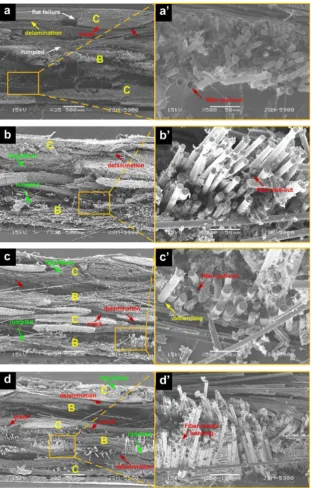Effect of stacking sequence on the flexural properties of hybrid
composites reinforced with carbon and basalt fibers
I.D.G. Ary Subagia
a,b, Yonjig Kim
a,c,⇑, Leonard D. Tijing
d, Cheol Sang Kim
a, Ho Kyong Shon
daDivision of Mechanical Design Engineering, College of Engineering, Chonbuk National University, 567 Baekje-daero, Deokjin-gu, Jeonju, Jeonbuk 561-756, Republic of Korea bMechanical Engineering, Faculty of Udayana University, Denpasar, Bali, Indonesia
cAdvanced Wind Power System Research Center, Chonbuk National University, Jeonju, Jeonbuk 561-756, Republic of Korea
dSchool of Civil and Environmental Engineering, University of Technology, Sydney (UTS), P.O. Box 123, Broadway, NSW 2007, Australia
a r t i c l e
i n f o
Article history:
Received 6 September 2012
Received in revised form 2 October 2013 Accepted 25 October 2013
E. Vacuum assisted resin transfer molding
a b s t r a c t
We investigated the effect of different stacking sequences of carbon and basalt fabrics on the flexural properties of hybrid composite laminates. The hybrid composites were fabricated using a vacuum-assisted resin transfer molding process. Three-point bending test was performed and the fracture sur-faces were examined by scanning electron microscopy. The present results showed that the flexural strength and modulus of hybrid composite laminates were strongly dependent on the sequence of fiber reinforcement. All the stacking sequences showed a positive hybridization effect. The interply hybrid composite with carbon fiber at the compressive side exhibited higher flexural strength and modulus than when basalt fabric was placed at the compressive side. Here, the proper stacking sequence of basalt and carbon fiber layers was found to improve the balance of the mechanical properties of the hybrid compos-ite laminate.
Ó2013 Elsevier Ltd. All rights reserved.
1. Introduction
In the last few decades, there has been increasing interest in using hybrid composite materials for structural applications due to their improved and better properties than their individual mate-rial constituent[1]. Hybrid composites are fabricated by combining two or more different reinforcement materials in a common ma-trix. By doing so, a new material is fabricated with new and addi-tional properties [2]. Carbon fibers are widely known reinforcement materials due to their superior properties such as high mechanical strength and modulus of elasticity[3], low den-sity, and good flame resistance. It makes carbon fiber irreplaceable in wide sectors of engineering technology such as for automobile, aircraft, ships, construction, and sport equipment[4–7]. However, carbon fiber composites are rather susceptible to stress concentra-tion due to the brittleness of carbon fiber[4]. In addition, carbon fiber involves costly production. One way to improve the weakness of carbon fiber reinforced plastic (CFRP) composite is by replacing some layers of the carbon fiber by ductile fibers. This is called hybridization, which can lead to benefits in cost and enhancement of mechanical and physical properties, thus creating new types of materials. Park and Jang[8]incorporated polyethylene (PE) fibers
with carbon fibers in an epoxy matrix to form a hybrid composite laminate. They used PE fibers because of its high elongation at break, and high specific strength and stiffness. They concluded that the mechanical properties of hybrid composite strongly depended on the reinforcing fiber position, such that, when carbon fiber was positioned at the outermost layer, the hybrid composite showed the highest flexural strength.
One of the recent promising materials for the fabrication of hy-brid composites is basalt fiber. As an inorganic fiber, basalt fiber has good strength, modulus, better strain to failure than carbon fi-ber, high operating temperature range, good chemical resistance, can easily be processed, eco-friendly, and inexpensive [9–11]. Some researchers have indicated that basalt fiber has comparable or even better tensile and compressive properties than glass fibers
[12,13]. Hence, basalt fibers gained increasing attention as a brand new reinforcing material for hybrid and composite laminates. Among the potential applications of the basalt-carbon fiber/epoxy composites would be on lightweight load bearing structures such as for vehicles. The weight of a vehicle directly impacts the energy consumption, i.e., less weight, less consumed energy. Carbon fiber composites are now being adopted in the automotive industry due to their excellent properties. The use of CFRP in cars could decrease the vehicle’s weight by 40–60%[14]. However, the high cost of car-bon fiber only limits its application to luxury cars and aerospace vehicles. Thus, there is a need to reduce the cost of CFRP without sacrificing a lot in its mechanical performance. The promising
1359-8368/$ - see front matterÓ2013 Elsevier Ltd. All rights reserved. http://dx.doi.org/10.1016/j.compositesb.2013.10.027
⇑ Corresponding author at: Division of Mechanical Design Engineering, College of Engineering, Chonbuk National University, 567 Baekje-daero, Deokjin-gu, Jeonju, Jeonbuk 561-756, Republic of Korea. Tel.: +82 63 270 4763; fax: +82 63 270 2460.
E-mail address:[email protected](Y. Kim).
Contents lists available atScienceDirect
Composites: Part B
properties and low cost of basalt fibers could be a potential candi-date as reinforcement for CFRP to obtain a lightweight and low-cost material (since basalt fiber is much cheaper than carbon fiber) with comparable mechanical performance with CFRP. Several researchers have studied the incorporation of basalt fibers with other reinforcement materials in composite laminates. Lopresto et al.[9]reported better Young’s modulus, compressive strength and flexural behavior for basalt fiber-reinforced plastic (BFRP) compared to glass fiber reinforced plastic, but the latter had better tensile strength. Manikandan et al.[15]concluded that basalt fiber composites showed generally superior properties than those of the glass fiber reinforced polymer. Extensive studies have been done on the improvement of properties of CFRP and BFRP by incorporat-ing nanoparticles[16–18], filler fibers[2,19], and surface modifica-tions [20] in the composite material. However, only very few studies have been carried out on the combination of carbon fiber and basalt fiber to affect the hybrid composite material properties. The hybridization of carbon fibers with basalt fibers would ulti-mately reduce the costs and expand the application fields of the hybrid composite material [21]. To the authors’ best knowledge, no study has been carried out yet on the effect of different stacking sequences and number of basalt fiber and carbon fiber layers in a hybrid composite laminate.
In this work, interply hybrid composites were prepared with carbon fiber and basalt fiber as reinforcements and epoxy resin as the matrix. Some of the factors that can influence the mechan-ical performance of the composite from the reinforcement include
Carbon fiber (C120-3K, woven, 200 ± 10 g/m) was supplied by Hyun Dai Fiber Co. Basalt fiber (EcoB4-F210, woven, 210 ± 10 g/ m2) was supplied by Seco-Tech. A mixture of epoxy (HTC-667C)
with modified aliphatic amine hardener was supplied by Jet Korea Co. and was used as the matrix.Tables 1 and 2show the properties of the present woven fabrics and epoxy resin, respectively.
2.2. Fabrication of hybrid composite laminates
The hybrid composite laminates were fabricated using a vac-uum-assisted resin transfer molding (VARTM) process. The VARTM is a liquid molding technique to manufacture complicated compos-ite structures[23]. Generally, VARTM process consists of five steps, which include: (a) mold preparation and fabric lay-up; (b) sealing of the mold and creating a vacuum; (c) resin preparation and degassing; (d) resin impregnation, and; (e) curing of fabricated panels. Here, the hybrid composite laminates were fabricated fol-lowing the flowchart shown inFig. 1a and the curing process in
Fig. 1b. The schematic layout of the present VARTM set-up is shown in Fig. 2. Carbon and basalt fabrics, cut to a size of 250 mm250 mm, were arranged with different stacking se-quences on a bronze plate mold (300 mm300 mm). In the pres-ent study, for each configuration of carbon–basalt/epoxy composite laminate, a total of ten plies of plain carbon and basalt woven fabrics were stacked in every laminate. The weight fraction of both carbon and basalt fibers was about 62 wt% in every panel of hybrid composite laminate. The lamina was then wrapped with a vacuum bagging film using a sealant tape (AT200Y). The epoxy re-sin with hardener (epoxy/hardener ratio of 5:1) was then injected into the mold through a vacuum pump with a pressure of80 kPa for more than 40 min. The wetted fiber reinforcements were cured in an autoclave for 2 h at a constant temperature and pressure of 65°C and 80 kPa, respectively.
Hardener Modified aliphatic amine
Tensile strength (MPa) 63.7
Compressive strength (MPa) 88.2
Flexural strength (MPa) 81.3
2.3. Measurement and characterization
Flexural tests were carried out according to ASTM D970-07[24]
using a three-point bending test measuring at least five specimens for each laminate. The tests were performed in a universal testing machine (Unitech-M, R&B) at a span-to-depth ratio of 32 and at a constant crosshead speed of 3 mm/min at room temperature. The bending test specimens had dimensions of 76.2 mm in length and 12.7 mm in width, which were all prepared by water jet machining. The fracture surface of each hybrid composite speci-mens was inspected and analyzed using a scanning electron
microscope (SEM, JEOL JSM-5900) after the flexural test. Micro-scopic analyses were performed aiming to identify the failure mode occurrence in the specimens tested.
3. Results and discussion
3.1. Flexural properties
A hybrid composite material possesses unique features that can be used to meet different design requirements with respect to strength, stiffness, and flexural behavior. A key parameter in hybrid composite structure is the arrangement of fiber within the hybrid. It was reported that the hybrid design strongly affects a variety of properties such as a flexural strength, modulus fatigue behavior
Fig. 2.Schematic layout of the present VARTM set-up.
Fig. 3.Different stacking sequences of carbon (C) and basalt (B) fiber plies.
Fig. 4.Load–displacement curves for CFRP, BFRP and interply hybrid composites with different stacking sequences.
Fig. 5.Average flexural strength and modulus of CFRP, BFRP and interply hybrid composites with different stacking sequences.
Table 3
Flexural properties of CFRP, BFRP, and hybrid composite laminates.
Name/stacking sequence Laminate codes
Flexural strength (MPa)
Flexural modulus (GPa)
C10 jjjjjjjjjj CFRP 860.929 54.172
C3B4C3 jjjhhhhjjj H1 740.197 45.438
C6B4 jjjjjjhhhh H2 738.265 41.104
C3B2C3B2 jjjhhjjjhh H3 737.255 40.331
C2B2C2B2C2 jjhhjjhhjj H4 717.133 46.408
B4C6 hhhhjjjjjj H5 712.120 39.026
B2C3B2C3 hhjjjhhjjj H6 679.267 34.512
B2C6B2 hhjjjjjjhh H7 655.720 35.006
B10 hhhhhhhhhh BFRP 428.058 25.374
and impact performance of hybrid composite upon the perfor-mance of reinforcement and matrix. In addition, the mechanical properties of the hybrid composites strongly depend on the rein-forcing fiber position[8]. To check the effect of stacking sequence, we utilized 4 basalt fabric layers and 6 carbon fabric layers for a to-tal of 10 fabric layers incorporated in the composite laminate, and varied their stacking sequences according to the arrangements in
Fig. 3.
The flexural strength (
r
F) and modulus (EF) of the hybridcom-posites were determined according to the following equations
[24]:
r
F¼ ð3PLÞ=ð2bd2Þ ð1ÞEF¼ ðL3mÞ=ð4bd3Þ ð2Þ
whereL, b, d, P,andmrepresent the support span, width of speci-men, depth of specispeci-men, flexural load, and the initial slope of the load–displacement curve, respectively.
The typical load–displacement curves and the average flexural strength and modulus of the present hybrid laminates are shown inFigs. 4 and 5, respectively, and the calculated mechanical prop-erties are summarized inTable 3. InFig. 4, as expected, the CFRP shows a rapid and steep load rise, showing the highest load (i.e. flexural strength) among the tested samples, but it also showed a low displacement, indicating a brittle property. In contrary, the BFRP shows a slow load rise, obtaining the largest yield displace-ment and the lowest maximum load from among all tested sam-ples, suggesting that BFRP has good ductility primarily due to the high elongation property of basalt fiber. Thus, the presence of ba-salt fabric in carbon fiber-reinforced plastic is expected to add duc-tile properties to the hybrid composite material, but at the same time decreases the flexural strength. The hybrid composites with different stacking sequences of carbon and basalt fabrics (H1–H7) showed average values between those of CFRP and BFRP (see
Fig. 5andTable 3). Here, changing the stacking sequence clearly showed differences in the resulting properties of the composite laminates. The initial slopes of hybrid composite laminates H1, H2, H3, H4, H5, and H6 showed linear characteristics, i.e., a rapid
steep increase, whereas H7 exhibited non-linear characteristics, close to the characteristics of BFRP. Placing carbon fiber layers at the compressive side was found to increase the flexural strength and modulus of the hybrid composites when compared to placing basalt fiber layer on the compressive side. When the load was ap-plied, the outermost layer bears most of the applied load, so that a high flexural strength was achieved when carbon fibers were lo-cated at the skin region. The flexural strength of H1, i.e., 3 carbon fiber layers at the compressive side, was 740.197 MPa, which was about 86% of that of the plain CFRP (860.929 MPa). Similar re-sults were also observed by Park and Jang[8]when they combined carbon fiber and PE fiber at different sequences. Zhang et al.[22]
also reported increased flexural strength when they placed two carbon fiber layers on the compressive side of their glass/carbon hybrid composite laminates. Additionally, we have observed that when carbon fabric layers were placed in both the compressive and tension sides, i.e., H4, it results into high flexural strength and modulus. When basalt fabric was placed at the compressive side, the flexural behavior depended on what material was placed also at the tension side. In the case of H5 and H6, where basalt layer was placed in the compressive side, and carbon layer at the tension side, both composite laminates showed similar flexural strength and displacement (seeTable 3). However, when both ba-salt layers were on the compressive and tension sides, i.e., H7, the result (Fig. 4i) showed good ductility, but lower flexural strength. The present results suggest that the incorporation of basalt fiber layer in CFRP could improve the balance of the mechanical proper-ties[25]depending on the stacking sequence.
3.2. Fracture characteristics of hybrid composites
The common failures under flexural loading includes compres-sive failure, tensile failure, shear and/or delamination, wherein fail-ure by compression is the most common[26]. Compressive failure includes kinking, microbuckling, shear or splitting. The failure of a hybrid composite is dependent on the maximum bending moment that the individual constituent material could carry. Due to differ-ent characteristics such as failure strain of compondiffer-ent material in a hybrid matrix, the critical location may not always lie on the
surface ply[22]. To provide insight on the damage mechanism of the present samples after flexural test, optical and SEM images were taken on the front and fractured surfaces of the hybrid composites.
Representative photographic images are shown inFig. 6for the top and bottom sides of the tested specimens. FromFig. 6a, it can be seen that the typical failure of carbon fiber stacked at the com-pressive side is the crack propagation, whereas, no obvious cracks were seen when basalt fibers were placed at the compressive side after the flexural load (Fig. 6b). When carbon fiber layer was placed on the tension side (Fig. 6a0), few straight cracks were observed
after flexural tensile load. This phenomenon is attributed to the brittle failure of carbon fibers, where the specimen broke through all layers with abundant carbon fiber rupture[22]. Crack propaga-tion at the compressive side was also observed by de Paiva et al.
[27]using CFRP for aeronautical field. Usually, in CFRP, the fatigue stress is effectively transferred along the carbon fibers[28], so that
high flexural strength is achieved for CFRP but with more brittle property. On the other hand, the tested specimen with basalt fibers placed on the tension side showed tensile failure mode (Fig. 6b0),
which is consistent with the observation of other studies[9].
Figs. 7–9present the optical and SEM images of the cross-sec-tions of the failed flexural test specimens. In the present study, the composition of basalt to carbon fiber ratio was maintained con-stant at 4:6; only the stacking sequence was varied. H1 shows crack initiation (Figs. 7 and 8a) at the carbon fiber layer and in the matrix (Fig. 7a), and fabric buckling and delamination (Figs. 7 and 8a) were also observed. A closer look inFig. 8a0 (H1) shows
few basalt fiber pull-outs, which could be due to inefficient ba-salt-epoxy bonding. The cracking at the early stages of damage of the matrix and the carbon fiber was being blunted at the basalt fabric/matrix interface and slowed down the damage propagation until the basalt fiber failed primarily from buckling and delamina-tion. In all other specimens (H2–H7) (see Figs. 7b–g, 8b–d, and
9a–c), we can see some debonding, buckling and longitudinal fi-ber–matrix delamination failures. One cause of the onset of buck-ling is due to the curvature or waviness [29]of the component fabric, especially basalt fabric. H2 (Figs. 7 and 8b and b0) showed
rapid crack propagation in the carbon fabric layers and buckling at the basalt fabric layers. Here, the carbon fabric was located at the outermost compressive side layer, which absorbed most of the applied load, leading to good tensile strength and modulus. Hy-brid composites H3 (Fig. 7c) and H4 (Fig. 7d) with plain carbon fi-ber at the compressive region exhibited some cracks along the center line of flexural load, which are attributed to the brittle fail-ure behavior of plain carbon fiber. Delamination was also observed in the region between the plain carbon and plain basalt fiber (Fig. 8c, c0 and d, d0). Both H3 and H4 showed similar values for
flexural strength and modulus (Fig. 5), but the latter (H4) showed better ductility (Fig. 4), which could be attributed to its better fab-ric dispersion arrangement. In H4, good fiber–matrix bonding was observed (Fig. 8d0), and the dispersed basalt fibers hindered the
crack damage in the matrix and carbon fibers from propagating leading to high flexural modulus. The dispersion extent of fabrics refers to the number of same fabrics being arranged next or neigh-bored to each other. In H3, the SEM images (seeFig. 8c and c0)
pro-vide epro-vidences of fiber pull-outs and voids that were not totally filled with epoxy matrix, which could explain its lower modulus than H4. The basalt fiber layers in the compressive region of H3 were failed with the typical kinking-slitting mode. The hybrid composites with basalt fiber at the outermost layers of the compressive side (i.e., H5, H6, H7) (seeFig. 9a–c) showed better
ductility than those composites with carbon fiber at the compres-sive side (i.e., H1, H2, H3 and H4) (Fig. 8a–d) regardless of the ex-tent of fabric dispersion arrangement. Kinking of the basalt fibers, cracking of the matrix and the carbon fibers, and delamination of carbon fiber–matrix were the common occurrences for H5, H6 and H7 composites. When both basalt fabrics were located in the compressive and tensile sides (H7, seeFig. 9c), high ductility was observed (seeFig. 4). All specimens (seeFig. 7) did not show com-plete break up of fractured laminate into two halves, which is attributed to the bridging effect of the basalt fiber layers [22]. The instabilities of the specimens under flexural loading are usu-ally preceded with a longitudinal fabric–matrix interface cracking, leading to failure[29]as can be clearly seen inFig. 7. InFigs. 8 and 9, we can observe that the carbon fiber failed in flat features and basalt fiber failed in rumpled fiber appearance after flexural load. The fracture surfaces in Fig. 8a0–d0 and Fig. 9a0–c0 indicate that
the basalt fibers break and burst into many strands and interfaces are nearly broken down, as similarly observed by Wei et al.[30].
4. Conclusions
This study explored the possibility of incorporating basalt fibers into carbon fiber reinforced composite and investigated the effect of stacking sequence on the flexural properties of the hybrid com-posite. This could provide opportunity to using basalt–carbon/ epoxy composite laminate for applications where carbon fiber is
largely applied. Here, vacuum assisted resin transfer molding (VARTM) process was used to fabricate the interply hybrid com-posites. Interply carbon–basalt/epoxy hybrid composites contain-ing four layers of basalt fabrics and six layers of carbon fabrics with different stacking sequences were tested for their flexural properties. Flexural tests were carried out according to ASTM D970, and optical and SEM images were obtained to characterize the fractured surfaces of the hybrid composites. The results showed that the dominant failure mode was compressive failure. The stacking sequence was found to affect the flexural properties of the hybrid composites. Higher flexural strengths and modulus were obtained when carbon fiber layer was stacked at the com-pressive side (outer layer), with H1 (i.e., stacking three carbon fiber layer at the compressive side) showing the best flexural strength and modulus from among the stacking sequence arrangements. Fa-tigue stress is effectively distributed in carbon fibers, thus it can withstand more stress leading to higher flexural strength. The flex-ural strength follows the trend: CFRP > H1 > H2 > H3 > H4 > H5 > H6 > H7 > BFRP. The composite laminates with carbon fabric on the compressive side all showed >40 MPa of tensile modulus, while those laminates with basalt fabric in the compressive side all showed <40 MPa. However, a more ductile material could be obtained when both layers at the compressive and tension sides are made of basalt fibers. All the stacking sequences showed a po-sitive hybridization effect. The highest flexural strength was achieved with H1 arrangement (i.e., C3B4C3), showing an increase Fig. 9.Low and high magnification SEM images of the cross-section of the fractured surfaces of hybrid composite laminates with basalt layer at the compression side after flexural loading: (a and a0) H5, (b and b0) H6, and (c and c0) H3. (C: carbon fabric; B: basalt fabric).
funded by the Ministry of Science, ICT & Future Planning (2010-0022359). I.D.G. Ary Subagia acknowledges the support from the Degree General High Education (DGHE) postgraduate abroad scholarship of the Republic of Indonesia for his Ph.D. program at Chonbuk National University in South Korea.
References
[1]Dehkordi MT, Nosraty H, Shokrieh MM, Minak G, Ghelli D. The influence of hybridization on impact damage behavior and residual compression strength of intraply basalt/nylon hybrid composites. Mater Des 2013;43:283–90. [2]Dehkordi MT, Nosraty H, Shokrieh MM, Minak G, Ghelli D. Low velocity impact
properties of intra-ply hybrid composites based on basalt and nylon woven fabrics. Mater Des 2010;31(8):3835–44.
[3]Han SH, Oh HJ, Lee HC, Su SS. The effect of post-processing of carbon fibers on the mechanical properties of epoxy-based composites. Compos Part B-Eng 2012;45(1):172–7.
[4]de Paivaa JMF, dos Santos ADN, Rezendec MC. Mechanical and morphological characterizations of carbon fiber fabric reinforced epoxy composites used in aeronautical field. Mater Res 2009;12(3):367–74.
[5]Taketa I, Ustarroz J, Gorbatikh L, Lomov SV, Verpoest I. Interply hybrid composites with carbon fiber reinforced polypropylene and self-reinforced polypropylene. Compos Part A-Appl S 2010;41(8):927–32.
[6]Colombo C, Vergani L, Burman M. Static and fatigue characterisation of new basalt fibre reinforced composites. Compos Struct 2012;94(3):1165–74. [7]de la Rosa García P, Escamilla AC, Nieves González García M. Bending
reinforcement of timber beams with composite carbon fiber and basalt fiber materials. Compos Part B-Eng 2013;55:528–36.
[8]Park R, Jang J. Performance improvement of carbon fiber polyethylene fiber hybrid composites. J Mater Sci 1999;34(12):2903–10.
[9]Lopresto V, Leone C, De Iorio I. Mechanical characterisation of basalt fibre reinforced plastic. Compos Part B-Eng 2011;42(4):717–23.
[10]Wei B, Cao HL, Song SH. Degradation of basalt fibre and glass fibre/epoxy resin composites in seawater. Corros Sci 2011;53(1):426–31.
[11]Wang X, Wu Z, Wu G, Zhu H, Zen F. Enhancement of basalt FRP by hybridization for long-span cable-stayed bridge. Compos Part B-Eng 2013;44(1):184–92.
[18]An Q, Rider AN, Thostenson ET. Electrophoretic deposition of carbon nanotubes onto carbon-fiber fabric for production of carbon/epoxy composites with improved mechanical properties. Carbon 2012;50(11):4130–43.
[19]Kalam A, Sahari BB, Khalid YA, Wong SV. Fatigue behaviour of oil palm fruit bunch fibre/epoxy and carbon fibre/epoxy composites. Compos Struct 2005;71(1):34–44.
[20]Zhang H, Zhang Z, Breidt C. Comparison of short carbon fibre surface treatments on epoxy composites – I. Enhancement of the mechanical properties. Compos Sci Technol 2004;64(13–14):2021–9.
[21]Artemenko SE, Kadykova YA. Polymer composite materials based on carbon, basalt, and glass fibres. Fibre Chem 2008;40(1):37–9.
[22]Zhang J, Chaisombat K, He S, Wang CH. Hybrid composite laminates reinforced with glass/carbon woven fabrics for lightweight load bearing structures. Mater Des 2012;36:75–80.
[23]Dai J, Pellaton D, Hahn HT. A comparative study of vacuum-assisted resin transfer molding (VARTM) for sandwich panels. Polym Compos 2003;24(6):672–85.
[24] ASTM International, standard test methods for flexural properties of unreinforced and reinforced plastics and electrical insulating materials. In: D70. West Conshohocken, PA: ASTM International; 2007.
[25]Naik NK, Ramasimha R, Arya H, Prabhu SV, ShamaRao N. Impact response and damage tolerance characteristics of glass–carbon/epoxy hybrid composite plates. Compos Part B-Eng 2001;32(7):565–74.
[26]Dong CS, Ranaweera-Jayawardena HA, Davies IJ. Flexural properties of hybrid composites reinforced by S-2 glass and T700S carbon fibres. Compos Part B-Eng 2012;43(2):573–81.
[27]de Paiva JMF, dos Santos AD, Rezende MC. Mechanical and morphological characterizations of carbon fiber fabric reinforced epoxy composites used in aeronautical field. Mater Res Ibero Am J 2009;12(3):367–74.
[28]Dorigato A, Pegoretti A. Fatigue resistance of basalt fibers-reinforced laminates. J Compos Mater 2012;46(15):1773–85.
[29]Davis DC, Wilkerson JW, Zhu JA, Ayewah DOO. Improvements in mechanical properties of a carbon fiber epoxy composite using nanotube science and technology. Compos Struct 2010;92(11):2653–62.
